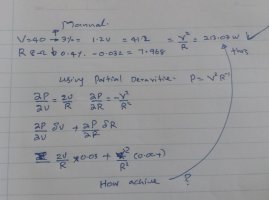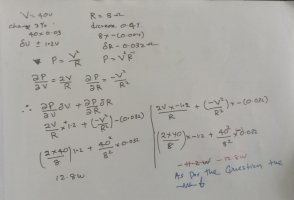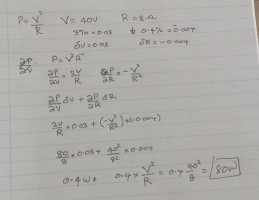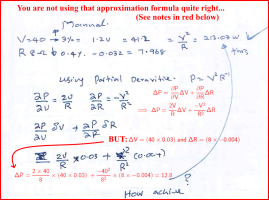Please check my answer: power consumed by resistor is given by P = (V^2/R) watts; determine approx. change when...
- Thread starter PA3040D
- Start date
I did not check the "arithmetic" ........ Looks good to mePlease check my answer is correct and point out the wrong
Question
View attachment 37960
Answer
View attachment 37961
You have a little mistakes. I told you before that if δV is the error then VδV is the percentage error.
δV=0.03
δR=−0.004
In the problem, you were given VδV=0.03 and RδR=−0.004.
Now you can find δV and δR and solve the problem correctly.
δV=0.03
δR=−0.004
In the problem, you were given VδV=0.03 and RδR=−0.004.
Now you can find δV and δR and solve the problem correctly.
Hi Grate thanks for advise !
I still have a few doubts about this. According to the manual method, the correct answer is obtained, but I'm unsure how to arrive at the same result using partial derivatives. I began working on it but stopped midway because I couldn't foresee the answer. Can you help to continuve whew I stopped

I still have a few doubts about this. According to the manual method, the correct answer is obtained, but I'm unsure how to arrive at the same result using partial derivatives. I began working on it but stopped midway because I couldn't foresee the answer. Can you help to continuve whew I stopped

The Highlander
Senior Member
- Joined
- Feb 18, 2022
- Messages
- 1,169
I don't understand why you are involving partial derivatives in the first place!Hi Grate thanks for advise !
I still have a few doubts about this. According to the manual method, the correct answer is obtained, but I'm unsure how to arrive at the same result using partial derivatives. I began working on it but stopped midway because I couldn't foresee the answer. Can you help to continuve whew I stopped
View attachment 37964
It may have been of some (limited?) use to introduce them in your previous thread, where you were working with errors(?), (I haven't checked their actual usefulness there) but this question has (little or) nothing to do with errors and so it is neither necessary nor appropriate to employ partial derivatives!
The question only involves changing values (for Voltage & Resistance) and what effects these changes will have on Power consumption.
You correctly calculated the Power (c.213.03 W) for when the Voltage increased by 3% but the question doesn't say it increased by 3%; it says it changes by 3%! So you will need to consider both cases, ie: when the Voltage increases by 3% and also when it decreases by 3%!
Furthermore, the question tells you to: "Determine the approximate change in power ...", so, when you correctly calculated the power consumption after a 3% increase in Voltage, you still hadn't completed even that part of the question. You were tasked with describing how Power had changed and, given the way the question has been written, I would expect that they want you to express that change as a percentage.
So please now re-do your working (omitting any partial derivatives) for both new Voltage levels and come back and show us that for confirmation that your working is correct.
You should arrive at results similar to these...
Hope that helps.
Dear OP,
There are two changes. Actual change and approximate change.
The actual change is:
7.96841.22−8402≈13.03
Which means:
New Power =8402+13.03=213.03 W
The approximate change is what you use partial derivatives to find which is:
δP=28402∗0.03+8402∗0.004=12.8
Which means:
New Power =8402+12.8=212.8 W
Did the problem ask you to find actual or approximate change???

There are two changes. Actual change and approximate change.
The actual change is:
7.96841.22−8402≈13.03
Which means:
New Power =8402+13.03=213.03 W
The approximate change is what you use partial derivatives to find which is:
δP=28402∗0.03+8402∗0.004=12.8
Which means:
New Power =8402+12.8=212.8 W
Did the problem ask you to find actual or approximate change???
The Highlander
Senior Member
- Joined
- Feb 18, 2022
- Messages
- 1,169
I apologize for not mentioning it earlier. These are City & Guilds Level 5 Mathematics exam questions. According to the lecture, these questions are meant to assess the application of partial derivatives in practical situations. Anyway Thank you for pointing out the valuable error. However, I still have a minor doubt regarding the interpretation of 'voltage change.' You are correct that it should indicate either an increase or decrease, but I'm unsure if both should be included in the answer. Should there be two separate answers. Please advise.I don't understand why you are involving partial derivatives in the first place!
It may have been of some (limited?) use to introduce them in your previous thread, where you were working with errors(?), (I haven't checked their actual usefulness there) but this question has (little or) nothing to do with errors and so it is neither necessary nor appropriate to employ partial derivatives!
The question only involves changing values (for Voltage & Resistance) and what effects these changes will have on Power consumption.
You correctly calculated the Power (c.213.03 W) for when the Voltage increased by 3% but the question doesn't say it increased by 3%; it says it changes by 3%! So you will need to consider both cases, ie: when the Voltage increases by 3% and also when it decreases by 3%!
Furthermore, the question tells you to: "Determine the approximate change in power ...", so, when you correctly calculated the power consumption after a 3% increase in Voltage, you still hadn't completed even that part of the question. You were tasked with describing how Power had changed and, given the way the question has been written, I would expect that they want you to express that change as a percentage.
So please now re-do your working (omitting any partial derivatives) for both new Voltage levels and come back and show us that for confirmation that your working is correct.
You should arrive at results similar to these...
Hope that helps.
As per your request I I re do base your advice please check

I believe that the actual approximate power increase around 12.8/2 = 6.4W% but can not prove
Grate thanks you always help me honestlyDear OP,
There are two changes. Actual change and approximate change.
The actual change is:
7.96841.22−8402≈13.03
Which means:
New Power =8402+13.03=213.03 W
The approximate change is what you use partial derivatives to find which is:
δP=28402∗0.03+8402∗0.004=12.8
Which means:
New Power =8402+12.8=212.8 W
Did the problem ask you to find actual or approximate change???

The Highlander
Senior Member
- Joined
- Feb 18, 2022
- Messages
- 1,169
I don't understand what you are getting at here!I believe that the actual approximate power increase around 12.8/2 = 6.4W% but can not prove
As has been pointed out above (more than once):-
The actual power increase is: c.13.03 W (c.6.52%)
and
The approximate power increase is: 12.8 W (6.4%)
("6.4W%" is not a valid representation of this! Percentages do not include units; they are pure numbers.)
Why on earth do you want to divide the 12.8 (W) by 2???
and what, exactly, is it that you feel some need to "prove"? (And what, precisely, is preventing you from doing so?)
I note that you still haven't addressed the issue of the Voltage reducing by 3% instead of increasing by that amount! Have you decided just to ignore that possibility (or assumed that the question didn't expect it to be addressed)?
Edit: I'm not going to re-write or amend anything above but I have just noticed that you have an "=" sign in there ("12.8/2 = 6.4W%"). The percentage increase (6.4%) just happens to be half of the approximate power increase (12.8 W) by pure coincidence (due to the original power consumption being 200 W)!
To calculate the percentage increase the sum is: (20012.8)×100%
But if you move the multiplication by 100 (to get a %-age fraction) inside the brackets, then the sum becomes:-
20012.8×100=212.8 (when you divide the top & bottom by 100).
Hope that helps.





